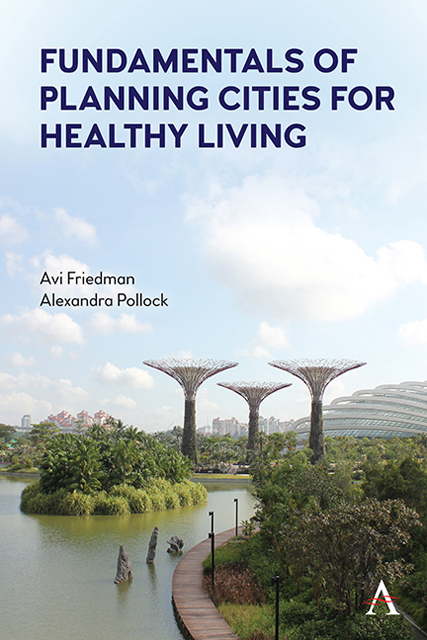Book contents
- Frontmatter
- Contents
- Preface
- Acknowledgments
- Chapter 1 The Broad View
- Chapter 2 Form, Function, and Public Health
- Chapter 3 Planning for Active Mobility
- Chapter 4 Green Open Spaces
- Chapter 5 Active Life in Winter Cities
- Chapter 6 Socializing in Communities
- Chapter 7 Food Production and Distribution
- Chapter 8 Urban Design for Healthy Aging
- Chapter 9 Public and Multi-Unit Residential Buildings and Public Health
- Chapter 10 Healthy Residences
- Chapter 11 Equitable Health Promotion
- Bibliography
- Bibliography for Case Studies
- Illustrations’ Credits
- Index
Chapter 1 - The Broad View
Published online by Cambridge University Press: 10 January 2023
- Frontmatter
- Contents
- Preface
- Acknowledgments
- Chapter 1 The Broad View
- Chapter 2 Form, Function, and Public Health
- Chapter 3 Planning for Active Mobility
- Chapter 4 Green Open Spaces
- Chapter 5 Active Life in Winter Cities
- Chapter 6 Socializing in Communities
- Chapter 7 Food Production and Distribution
- Chapter 8 Urban Design for Healthy Aging
- Chapter 9 Public and Multi-Unit Residential Buildings and Public Health
- Chapter 10 Healthy Residences
- Chapter 11 Equitable Health Promotion
- Bibliography
- Bibliography for Case Studies
- Illustrations’ Credits
- Index
Summary
Contemporary social, economic, and environmental challenges call for the rethinking of city planning and architectural design. The magnitude of challenges such as global warming, inequality, and population aging suggest that some current practices need to be revisited and altered. The challenges are further magnified when it comes to public health. Ominous indicators have become apparent during the COVID-19 pandemic, such as obesity and lack of accessible health care to lower income families, exemplifying the immediate need for action. This chapter begins with a background of what led to the decline of planning for healthy living, followed by a historical overview of the relations between health and sustainability. Finally, sustainable and health indicators will be outlined.
1.1 The Decline in Planning for Healthy Living
At its best, good urban design and planning practices hold the potential to improve people’s mental and physical health. In properly designed settings, residents can walk to a public transit stop at the start of a day, pause on their way for a coffee, and reach their nearby place of work where they will be within a walking distance of healthy lunch options. After work and on weekends, they may meet neighbors, jog along a trail, visit a cultural venue, or shop at a market.
Just as easily, poorly planned communities can facilitate unhealthy daily behaviors. Residents may drive a long distance to work on highways and stop at a drive-through fast-food restaurant. They may work in an office park with an uninteresting visual attraction that does not foster social engagement or encourage walking. They may reside in a place where oversized streets, a lack of sidewalks, and limited public green space may discourage outdoor exercise and limit their interaction with other people.
For decades, urban development was defined by the second example. Despite overwhelming evidence linking sprawl to negative health outcomes, dense and walkable settings were abandoned in favor of the comfort and affordability that low-density suburban subdivisions offer (Frumkin et al. 2004). At the same time, there has been a troubling decline in public health worldwide.
- Type
- Chapter
- Information
- Fundamentals of Planning Cities for Healthy Living , pp. 1 - 12Publisher: Anthem PressPrint publication year: 2022

